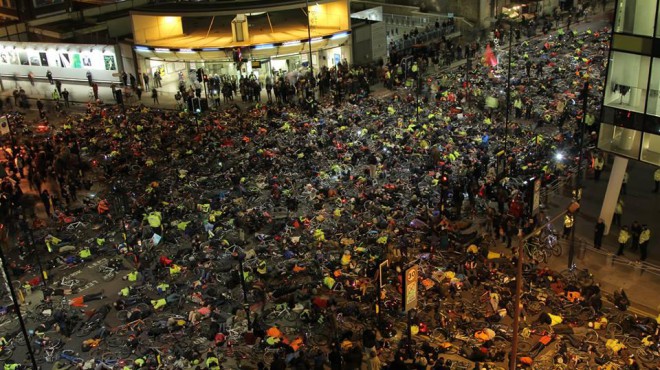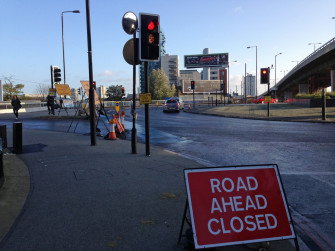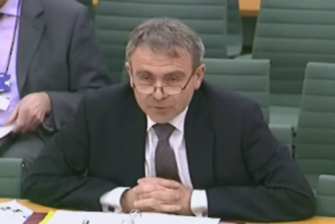
Cyclists in London: Turning Accidents and Protests into Advocacy and Politics
 Cyclists protesting for more safety in front of Transport for London (TfL)'s headquarters. Photo (c) Rory Jackson
Cyclists protesting for more safety in front of Transport for London (TfL)'s headquarters. Photo (c) Rory Jackson
Cycling has been front and centre in London during the past few weeks. Normally that's good news, but this time there is little to celebrate. Six cyclists have been killed on London's streets in November, an issue so grave that it forced the UK Parliament's Transport Committee into a session on the issue, brought more than 1000 cyclists onto the streets and got the attention of the EU Transport Commissioner.
Everything had been looking better than usual for cycling this year in the UK capital. By the 5th November, 8 cyclists had been killed in London. While that is a horrible tragedy for the cyclists and their families, and 8 too many for sure, statistically 2013 would still have been a very good year if that number had remained so low.
After all, cycle journey miles in London almost doubled from 118 million in 2002 to 209 million in 2012, while deaths sank from 20 to 14 in the same period. Albeit still unacceptably high as a number, 8 would have therefore been a safety record. But it didn't turn out that way.
Events take a wrong turn
It all started when Brian Holt, a hospital porter, was killed on Cycle Superhighway 2 (or CS2) when he was run over by a lorry on November 5. And from then on the bad news came flooding in. Two more cyclists died on the same Cycle Superhighway, and three others on dangerous junctions elsewhere. What the crashes all have in common is that each time, there was a lorry, coach or bus involved.
Heated exchanges followed between UK cycling advocates, London's mayor Boris Johnson and Transport for London (TfL), the city's transport agency. Cyclists accused Johnson and TfL of not doing enough to protect them, as most parts of the Cycle Superhighways are not segregated from motorized traffic (see this video for example). Yet they are one of Johnson's pet projects.
Cyclists became even more enraged as police embarked on a campaign pulling cyclists out of traffic who were not wearing helmets or high-vis vests in order to raise their awareness to do so (even though neither helmets nor vests are compulsory in Britain). Banning lorries in Central London was put on the table, as was banning cyclists wearing earphones - although there is no evidence the victims of the November crashes had been wearing them.
The London Cycling campaign and the CTC have repeatedly said that actions such as the one run by the police amount to victim-blaming. "No high-vis vest or helmet can protect you from the crushing power of a 40-ton Heavy Goods Vehicle, coach or bus," says Roger Geffen from CTC. It's hard to argue he hasn't got a point.
A die-in with 1000 participants and debate in Parliament
Attention reached a provisional high point on 30 November when more than 1000 cyclists took to the streets for a die-in protest outside TfL's headquarters. Two weeks earlier, cyclists had already staged a protest at Bow roundabout, one of the most dangerous sections of Cycle Superhighway 2.
This week, cycling safety was even being discussed in the Transport Committee of the House of Commons, the Lower House of the British Parliament (Alec James of ECF member Sustrans covered the meeting via twitter). And Siim Kallas, EU Commissioner for transport, met with TfL commissioner Sir Peter Henley, and agreed that cyclist safety is a critical issue.
“Perhaps the real problem with UK cycling was unintentionally exposed during the Transport Committee session on cycling,” says ECF Road Safety Officer Ceri Woolsgrove, who followed the meeting via the live stream. Ceri says that despite a wealth of expertise to call on (CTC, Sustrans, PACTS, etc. etc.), "the quality of questioning and debate from MPs at the committee was shambolic and did not show one ounce of preparation, nor any intention to take the subject seriously."
As examples, Ceri quotes Labour MP Sarah Champion championing mandatory helmet law, which would have done nothing to prevent a single one of the six fatalities the meeting was about. There were questions about warring cyclists, road tax (hasn’t existed since Winston Churchill repealed it in 1939!), anecdotes about cyclists cutting up lorries and much more – just how to make cyclists safer was not even remotely being discussed.
…but there is hope: waiting for the Cycling Delivery Plan
Campaigning for the Cycling Revolution
Earlier this year, the ‘Get Britain Cycling’ inquiry, conducted by the UK’s All Party Parliamentary Cycling Group (supported by CTC, Sustrans and others) made several hard-hitting and widely supported recommendations. One was that annual spending on cycling should amount to at least £10 per head annually, for the long term. In response, UK Prime Minister David Cameron promised to launch a “Cycling Revolution”, but allocated £10 per head for just 1/10th of Britain’s population, for just 2 years.
A few days later however, the committee seemed to have drawn some lessons from this heavily criticized first session when they interviewed Robert Goodwill, the Minister for cycling and road safety (read the CTC’s report here). “But more importantly, we are shortly awaiting the first draft of the Government’s Cycling Delivery Plan” says Roger Geffen.
“When they were preparing the plan, officials from the Department of Transport (DfT) have been proving very receptive to what we and other cycling groups in the UK have been saying to them”, Roger explains (see also his blog post about the plan). "However, Transport Ministers and officials still aren’t committed to ensuring that local authorities, developers and others achieve high and consistent standards of cycle-friendly design in all highway and traffic schemes, something CTC and others have long been asking for."
Nor has the Department for Transport yet succeeded in persuading other key Government departments to support their aims, Roger says. "The departments for planning and for education are being particularly obstructive. The major obstacle though is the Treasury! They need to be won over if cycling in Britain is to receive the funding it so needs and deserves, if it is to become a safe and normal means of getting around, for people of all ages and backgrounds."
Roger Geffen says it's too early to celebrate, though. The campaigning therefore will doubtless continue – both in the corridors of power and on the streets.
Karsten Marhold works as Communications Assistant at the European Cyclists’ Federation. He has a masters degree in European history and cultures and is a researcher in European Integration in Brussels. His interests focus on cycling as a sustainable form of mobility and the corresponding EU policies.
- Log in to post comments
Contact the author
Recent news!
Upcoming events
Contact Us
Avenue des Arts, 7-8
Postal address: Rue de la Charité, 22
1210 Brussels, Belgium












